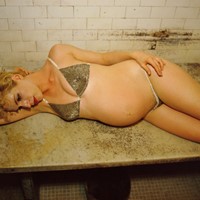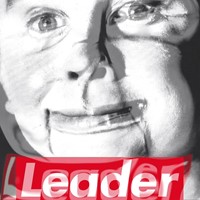Why the British art scene has changed beyond recognition since the golden age of the Young British Artists in the 1980s
Introducing Horror Nation?, a new season from Dazed about the current state of the UK from the perspective of the young people who live here. Over the course of this week, we will be celebrating the good that is happening all across the country – the culture and the creativity, the artists and the activists, the positive forces for change. But we will also be confronting the reality that life is getting increasingly challenging for British youth, and that Britishness itself is in flux, or even crisis. Stay with us as we lift the lid on modern Britain and ask whether this really is a horror nation.
Britain has always owed its art schools a big thank you. Our world-renowned institutions have trained the likes of David Hockney, Alexander McQueen, David Bowie, Vivienne Westwood and countless other legendary artists. Yet despite our history of producing some of the most important designers, musicians and artists of the past century, are Britain’s art schools what they once were, especially in the midst of ongoing Tory cuts to the arts?
In the late 80s, Britain’s art schools, particularly Goldsmiths College of Art, began to be recognised as the home of the Young British Artists (YBAs). They fostered new forms of innovation using shocking imagery and found objects, with members including the likes of Damien Hirst, Angus Fairhunt and Sarah Lucas. Today, while Britain’s art schools are still world-famous, the classes of 2023 are reckoning with growing government contempt for the arts. Remember Fatima the ballerina? Whose next job could be in cyber (she just doesn’t know it yet)? Yeah, we wish we could forget that one too.
Art schools used to be a refuge for Britain’s most creative minds – regardless of whether they were wealthy or not. Hirst, for example, once said that his family was so poor he’d often look around hoping to find a “pound note” on the floor while growing up in Leeds. But today, the landscape is very different. Tuition fees rising to £9,250 in 2012 has doubtless deterred some creatives from poorer backgrounds from applying to university at all, while others might have opted to study a course with better graduate earnings potential (creative graduates, generally speaking, earn less than graduates of STEM subjects). It makes sense that people are concerned about how much money they’ll make after graduating now that a university education involves getting into thousands of pounds of student debt – and especially as we’re still living through a period of rampant inflation.
Arts subjects also have the potential to be more expensive than other courses, with many students having to shell out for necessary materials and supplies (such as sketchbooks, paint, or fabric). Some drama schools also charge as much as £80 for an audition; 19-year-old performing arts student Aiva Tambourini was only able to audition at Royal Central because of the university’s ‘fair access’ scheme, which offers eligible applicants free auditions. Speaking to Dazed, she says she knew her background put her at a disadvantage when it came to breaking into the arts industry. “I had to work and save up a lot of money just to pay for the auditions. If you have money you can audition to as many places as you want, but if you don’t you can’t,” she says. “And when you get to the audition, a lot of the questions are like: ‘what have you been to see? What have you done?’. It’s hard to train in the arts if you don’t have money.”
“The people who will make history as artists are the people who are playing with transgression. People should never feel totally comfortable with the art being made. Something dangerous will not sell in the moment” – TJ Finley
With all this in mind, it’s unsurprising that art schools are some of the most elitist universities in the country: research published in 2018 found that just 55 per cent of students accepted to study at the Courtauld in 2016 went to state schools, despite state-educated students making up 90 per cent of all new undergraduates in the same year. Even the University of Cambridge admitted more state-educated students (63 per cent) in the same year. Additionally, working-class representation in creative industries is just 50 per cent of what it was in the 1970s.
Economic factors aside, the government also seems hellbent on quashing the arts. In 2021, it slashed funding to art and design courses in the UK by 50 per cent and has suggested that creative courses will be scrutinised as part of its crackdown on ‘Mickey Mouse’ degrees. They’re also set to introduce new immigration rules in 2024 which will result in most international students being banned from bringing their families to the UK with them. International students often comprise a sizeable chunk of the student body at art schools – they make up 32 per cent of students at the Courtauld Institute of Art and 47.9 per cent at the University of the Arts London (UAL) – so with fewer students contributing both financially and creatively to institutions like these, it seems likely that art schools are destined to struggle in years to come.
This isn’t just an issue of ‘representation for representation’s sake’, either. It’s vital working-class creatives are still able to access Britain’s art schools not only because it’s fair, but also because they’re good. Case in point: TJ Finley. Finley showcased perhaps the most subversive and shocking collection of the whole CSM graduate show last month, titled ‘Fags Forking the Rich’. The collection was a love letter to their working-class background, inspired by the textures of a decaying windmill home to heroin and crack users visible from their childhood bedroom window. For the collection, TJ crafted garments made from knitted leather and cigarette butts woven into the fabric, and also controversially pelted celebrity guests with cigarette butts during the show.
“I had to keep my idea a secret. I couldn’t tell the tutors what I was planning, they would have tried to stop me,” they say. For TJ, the school of today is a long way from its iconic legacy. “CSM is not an art school, it’s a business. You know that when you’re walking in and paying nearly £6 for a cup of coffee,” they say, adding that they believe things have only gotten worse since CSM announced a partnership with luxury goods giant LVMH in 2017. In TJ’s view, LVMH is driving CSM away from its more transgressive roots and towards churning out ‘safe’, palatable designs which will earn the most money.
“Even these big scholarships are for people who they know will get a job within a brand which is functioning on commerciality and can constantly sell. So what’s happening to the legacy?”, TJ says. “The people who will make history as artists are the people who are playing with transgression. People should never feel totally comfortable with the art being made. Something dangerous will not sell in the moment,” they continue. “When great designers first release their work there is more backlash than support because people don’t get it, or don’t want to support it.”
Can we still consider CSM and other iconic art schools as a jewel in Britain’s prestigious crown of creativity, when commercially successful work is seen as more ‘valuable’ than anything disruptive or transgressive? When higher education is increasingly commodified? When art schools are becoming dominated by wealthier students, while poorer creatives are barred from entry? The growing elitism of Britain’s art world is in conflict with the creation of radical, subversive art which these institutions are historically known for – and without making space for talent from all walks of life, Britain risks letting the next generation of innovative artists slip through the net.
Join Dazed Club and be part of our world! You get exclusive access to events, parties, festivals and our editors, as well as a free subscription to Dazed for a year. Join for £5/month today.




